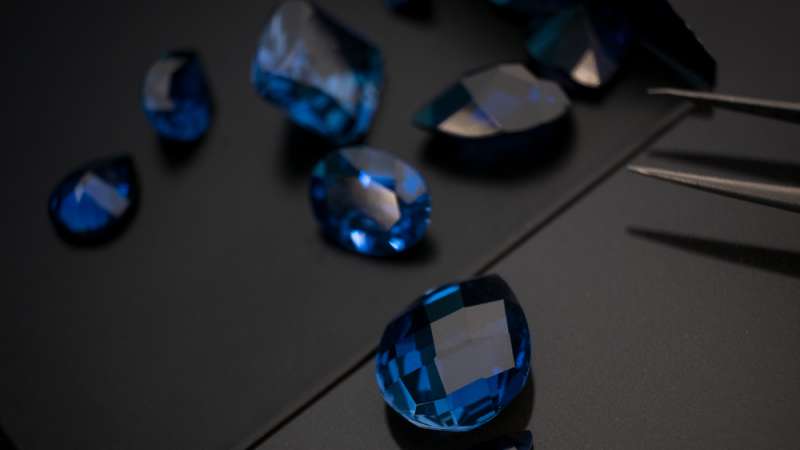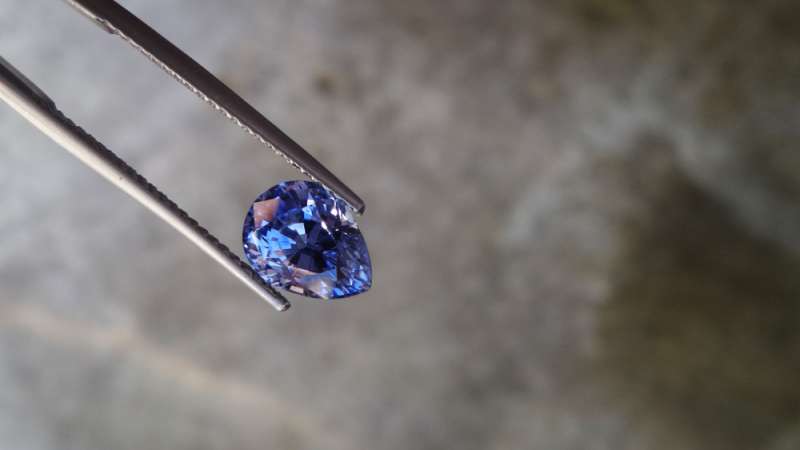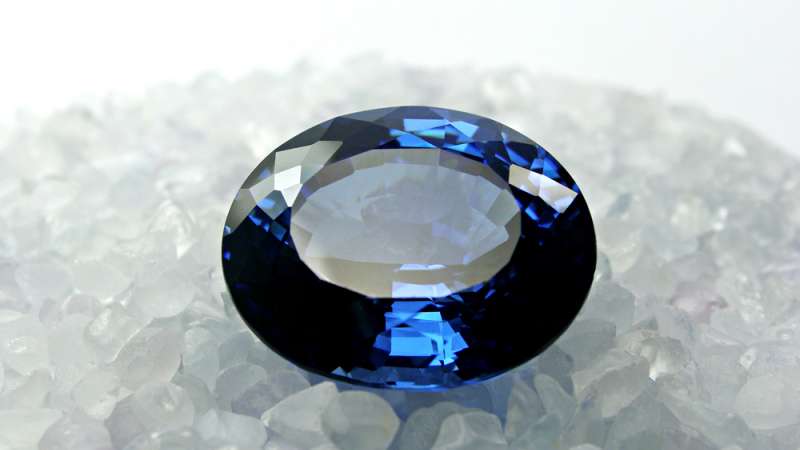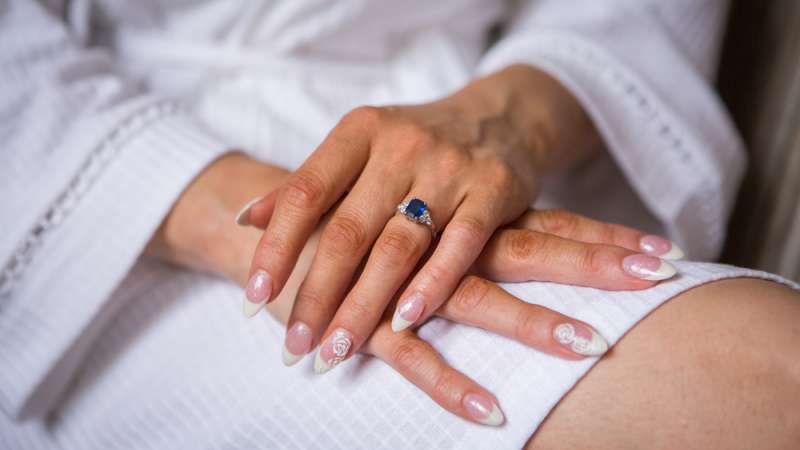Sapphires have gained popularity as a stunning choice for jewelry. While diamonds may be the top choice, sapphires can serve as beautiful centerpieces for engagement rings or necklaces.
When purchasing jewelry, it is crucial to test the gemstones for authenticity. While diamond testers are commonly used for diamonds, can they also be used to test sapphires? Is there a more effective method to verify the authenticity of sapphires? Discover the answers to these questions in our informative article.
DESIGN YOUR OWN ENGAGEMENT RING: START WITH A SETTING OR START WITH A DIAMOND. IT’S REALLY UP TO YOU!

Can You Test a Sapphire With a Diamond Tester?
Diamond testers are commonly used to quickly authenticate diamonds. However, their effectiveness in testing other gemstones varies. While diamond testers are primarily designed for diamonds, they can also be used to test certain other gemstones.
Sapphires, for instance, can often pass the test as genuine gemstones when using a diamond tester. Although sapphires differ from diamonds, diamond testers can still detect most rocks, including sapphires.
It’s important to note that diamonds have high thermal conductivity and exhibit a full spectrum of colors when sparkling, while sapphires typically sparkle in white or silver tones. While a sapphire may pass the diamond tester, it’s worth mentioning that not all gemstones, such as rubies, may yield accurate results due to their deep coloration.
While diamond testers can be useful for diamonds, it is crucial to approach their results with caution, especially when testing sapphires. To ensure the authenticity of your sapphire, it is recommended to conduct more comprehensive tests specifically designed for gemstone verification.

How to Determine if Your Sapphire Is Real?
Whether you have a new sapphire ring or inherited a piece, it’s important to verify the authenticity of the gemstone. Fortunately, you don’t have to rush to a jeweler right away, as there are several methods you can try at home to determine if your sapphire is genuine.
Flaws
Start by examining your sapphire for imperfections such as inclusions or cloudiness. If you can’t see any flaws with the naked eye, use a regular magnifying glass to get a closer look at the gem’s surface.
Authentic gemstones always have some degree of impurity and inclusions, which can be observed under a magnifying glass. Natural sapphires exhibit inclusions throughout, while fake gemstones may appear close to perfect. Keep in mind that almost flawless sapphires are rare in nature and are more likely to be imitations made of glass or lab-grown materials.
Certain inclusions can be visible to the naked eye, but most require a magnifying glass or even a microscope for detection. Look for needle-like inclusions that resemble silk, mineral crystals that appear lighter or darker than the sapphire, feather-like inclusions that resemble real feathers, and fingerprint-like inclusions that resemble human fingerprints.
Color Zoning
Pay attention to the color zoning of your sapphire. While sapphires are primarily blue, color zoning may cause some parts of the crystal to appear paler in comparison. Severe inclusions can create areas that appear whiter in color. However, color zoning alone is not a definitive indicator of authenticity.
Breath Test
Perform a breath test to further assess the authenticity of your sapphire. Blow onto the stone to fog it up and observe how quickly the fog dissipates. Genuine stones clear up within a few seconds, while glass or fake stones take longer to clear. A quick defogging indicates a real sapphire.
Texture Check
Inspect the texture of the sapphire for air bubbles, especially if you suspect it may be fake. Natural sapphires do not contain air bubbles, whereas fake gemstones, often made of glass, may exhibit them. Examine the crystal from different angles and consider using a magnifying glass for a more detailed assessment.
Scratch Test
The scratch test is another popular method to determine a gemstone’s authenticity. If you have a confirmed genuine sapphire, use it to scratch the surface of the gem in question. If the suspicious stone gets scratched easily, it is likely not real. Sapphires are known for their hardness and should not scratch easily.
Light Reflection
Evaluate how your sapphire reflects light by darkening the room and using a flashlight. Real sapphires reflect light exclusively in their own color, without any other hues. Fake sapphires, being made of glass, may reflect different colors. A deviation from the sapphire’s color in the light reflection indicates a potential fake.
Consult a Gemologist
If you have performed these tests and still have doubts about your sapphire’s authenticity, it’s advisable to consult a reputable gemologist. Seek recommendations from friends or check online reviews to find a qualified specialist. Gemologists have specialized tools, such as scopes and refractometers, to accurately determine the authenticity of gemstones. They can also provide insights into the quality of your sapphire, including any heat treatments that may have been applied, which can affect its value if you intend to sell it.

Determining the Value of Your Sapphire
Sapphires, along with emeralds and rubies, are well-known colored gemstones and minerals. While blue sapphires are the most popular, there are also fancy sapphire colors like pink, yellow, purple, and violet. The color of a sapphire significantly influences its price.
Blue sapphires are highly sought after and are often associated with the highest quality. The best sapphires are deep blue with a subtle violet undertone, ranging from medium to intensely dark blue. Lighter or almost black sapphires are valued less, while those in the middle color range tend to command higher prices.
In terms of clarity, sapphires generally have better clarity than rubies and emeralds, although they can still have inclusions. While high clarity sapphires are rare and expensive, it’s important to note that certain inclusions can actually increase the value of a sapphire. For instance, Kashmir sapphires with unique velvety inclusions are highly prized.
The cut of a sapphire also greatly affects its value. The rough shape of the sapphire determines its ideal cut, and most sapphires are shaped like hexagonal pyramids or barrels. The goal of the cut is to enhance the sapphire’s color and retain as much of its original weight as possible.
The carat weight of a sapphire is a crucial factor in determining its value. Sapphires can be found in a wide range of weights, from small points to large stones weighing hundreds of carats. While it is easier to find larger sapphires compared to rubies, it is rare to find large sapphires of the highest quality. Most larger stones are considered commercial-grade and may not match the quality of smaller sapphires, which often have higher clarity and better cuts.

Bottom Line
Lastly, there are various methods to determine the authenticity of a sapphire. All the techniques we discussed earlier, including the use of different types of diamond testers, can help you identify a natural sapphire.
However, it’s important to note that diamond testers are not completely foolproof, so it’s advisable to consult a qualified gemologist to get a definitive assessment. Keep in mind that gemologist services can be costly, as they may charge a fee for conducting a comprehensive report on the authenticity of your sapphire.
If all of this seems overwhelming, a simpler option is to acquire a diamond tester, either by purchasing one or ordering it online if you don’t have one already. This way, you can quickly test your sapphire crystal and get an initial indication of its authenticity.


